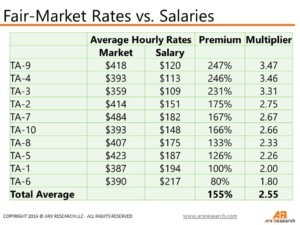New research shows the key differences between Physician Salaries vs FMV Rates used to establish fee schedules for payments to HCPs.
Payments made to physicians and thought leaders have been under scrutiny for many years and companies have been working to adjust their rates to level with industry standards and represent fair market value compensation (FMV) while still trying to stay competitive. The implementation of the U.S. Sunshine Act changed how life science organizations interact with healthcare providers, and many countries have also followed suit with their own reporting rules. Adjustments to “market-driven” fee schedules should be done periodically and are best done through independent 3rd party research, providing a fair and balanced assessment of rates. Sound establishment of rates should be done through the support of several sources.
Arx Research recently completed a large global study on fees paid to healthcare providers and thought leaders by life science organizations for various activities, such as consulting, speaking and advisory boards. These fees were categorized to segment fix rates and hourly rates by activity, specialties and level of influence of these paid healthcare professionals. Each study also contains salary data gathered from several sources to provide life science executives with comparative benchmarks.
We understand and recommend that companies look for various sources to establish educated fee schedules. Although we believe market driven rates – actual amounts paid to thought leaders – are more relevant and representative than salary data, many life science organizations still only use salary data to establish fee schedules.
Salary data may offer guideposts to establish baseline payment rates but our research indicates that the differences between salary data and actual market rates vary greatly and does not allow for the establishment of a “formulae” that would easily and safely derive rates adjusted to include premiums representative of market demand.
Table A below shows an analysis of 10 specialties, labeled “TA-x”. The average “Market” rates include all hourly fees regardless of activity and thought leader level of influence. The “Salary” average hourly rates include all salaries for specialists regardless of their level of pay. This allowed Arx Research analysts to compare “apples-for-apples” rates for each therapeutic area specialists.
The “Premium” column shows the percentage difference between the salary and market rates while the “Multiplier” column is an attempt to identify a potential common number that could help establish market rates.
Table A: Variations of Market and Salary Rates, Premiums and Multipliers
As the findings show, there are no correlation whatsoever between specialties. In addition, applying the average “Multiplier” of 2.55 to salaries rates would translate into market rates falling closer to the bottom of the rates and not fairly represent more than half of the specialties studied here. This would imply that companies using such system wouldn’t offer competitive fees to thought leaders in these categories and probably overpay specialists in the other categories.
Using “Multipliers” associated to each specialty would certainly yield better results. But again, this wouldn’t take into account the variations between thought leader levels of influence and even be less relevant for distinct activities. Furthermore, companies who use salary data often do not have enough market rates available to safely establish rate Premiums, making the exercise of developing fee schedules even more complicated.
Download a hardcopy of this article: arx-research-fact-sheet-7001-salary-vs-fmv-rates
Fair-Market Value Compensation Studies
The findings presented in this Fact Sheet are extracted from studies on fair-market value compensation available here:
WEBLINK: https://www.arxresearch.com/product-category/thought-leader-compensation/
physician salaries vs fmv rates
physician salaries vs fmv rates







